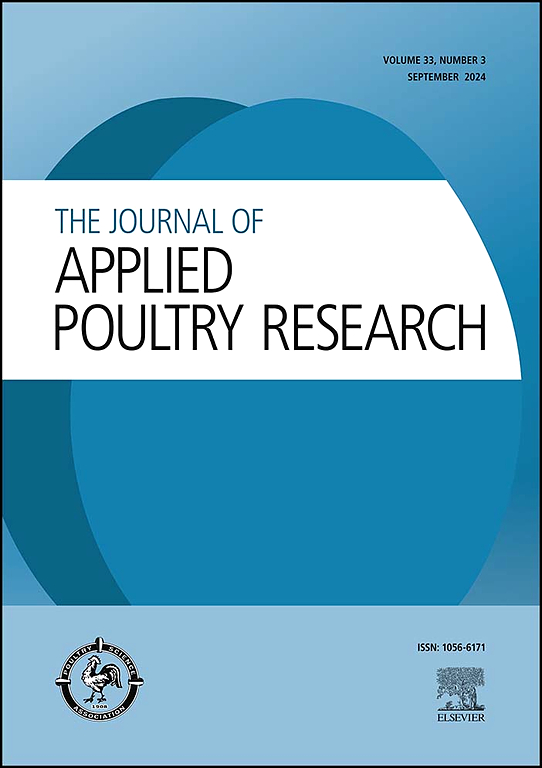Evaluation of different DNA extraction methods for the detection of Clostridium perfringens by loop-mediated isothermal amplification (LAMP) assay
IF 2
3区 农林科学
Q2 AGRICULTURE, DAIRY & ANIMAL SCIENCE
引用次数: 0
Abstract
Clostridium perfringens (C. perfringens) is a gram-positive bacterium that causes necrotic enteritis in poultry, resulting in significant economic losses. The development of a reliable and cost-effective diagnostic assay is crucial to prevent the spread of this bacterium. The loop-mediated isothermal amplification (LAMP) assay has emerged as a promising tool for in-field detection of C. perfringens. However, for effective implementation in low-resource settings, a simplified, low-cost DNA extraction method that minimizes equipment needs is crucial. This study aimed to identify an optimal DNA extraction method for the LAMP assay targeting C. perfringens detection. We evaluated four DNA extraction methods, Spin-column (SC), Magnetic Beads (MB), Dipstick (DS), and Hotshot (HS), based on DNA yield, purity, quality, and their compatibility with LAMP and PCR assays. The effectiveness of these methods was tested using spiked broiler feces with reference C. perfringens. Our findings indicated that SC and MB methods yielded DNA of higher purity and quality. Specifically, the SC method demonstrated superior performance in both LAMP and PCR assays across all tested C. perfringens strains. While the HS method was not the top performer, it proved to be the most practical for DNA extraction in resource-limited environments. Sensitivity tests for the LAMP assay showed the highest detection capability with SC-extracted DNA, while DS and HS methods exhibited lower sensitivity. In summary, this study provides valuable information for establishing a practical and adaptable diagnostic approach for C. perfringens detection in low-resource settings, with the HS-DNA extraction method as a feasible option for on-site LAMP assays.
环介导等温扩增(LAMP)法检测产气荚膜梭菌不同DNA提取方法的评价
产气荚膜梭菌(C. perfringens)是一种革兰氏阳性细菌,可引起家禽坏死性肠炎,造成重大经济损失。开发一种可靠和具有成本效益的诊断方法对于防止这种细菌的传播至关重要。环介导的等温扩增(LAMP)法已成为一种很有前途的现场检测产气荚膜荚膜梭菌的工具。然而,为了在低资源环境下有效实施,一种简化、低成本的DNA提取方法将设备需求降至最低是至关重要的。本研究旨在确定一种针对产气荚膜梭菌LAMP检测的最佳DNA提取方法。我们评估了四种DNA提取方法,Spin-column (SC)、Magnetic Beads (MB)、Dipstick (DS)和Hotshot (HS),基于DNA产率、纯度、质量及其与LAMP和PCR的相容性。以含产气荚膜荚膜梭菌的肉鸡粪便为对照,验证了上述方法的有效性。我们的研究结果表明,SC和MB方法获得的DNA纯度和质量更高。具体而言,SC方法在所有测试的产气荚膜荚膜杆菌菌株的LAMP和PCR检测中都表现出优越的性能。虽然HS方法不是最好的,但它被证明是在资源有限的环境中最实用的DNA提取方法。LAMP法对sc提取的DNA的灵敏度最高,而DS和HS法的灵敏度较低。综上所述,本研究为在低资源环境下建立一种实用且适应性强的产气荚膜荚膜杆菌检测诊断方法提供了有价值的信息,其中HS-DNA提取方法是现场LAMP检测的可行选择。
本文章由计算机程序翻译,如有差异,请以英文原文为准。
求助全文
约1分钟内获得全文
求助全文
来源期刊

Journal of Applied Poultry Research
农林科学-奶制品与动物科学
CiteScore
4.10
自引率
10.50%
发文量
80
审稿时长
104 days
期刊介绍:
The Journal of Applied Poultry Research (JAPR) publishes original research reports, field reports, and reviews on breeding, hatching, health and disease, layer management, meat bird processing and products, meat bird management, microbiology, food safety, nutrition, environment, sanitation, welfare, and economics. As of January 2020, JAPR will become an Open Access journal with no subscription charges, meaning authors who publish here can make their research immediately, permanently, and freely accessible worldwide while retaining copyright to their work. Papers submitted for publication after October 1, 2019 will be published as Open Access papers.
The readers of JAPR are in education, extension, industry, and government, including research, teaching, administration, veterinary medicine, management, production, quality assurance, product development, and technical services. Nutritionists, breeder flock supervisors, production managers, microbiologists, laboratory personnel, food safety and sanitation managers, poultry processing managers, feed manufacturers, and egg producers use JAPR to keep up with current applied poultry research.
 求助内容:
求助内容: 应助结果提醒方式:
应助结果提醒方式:


